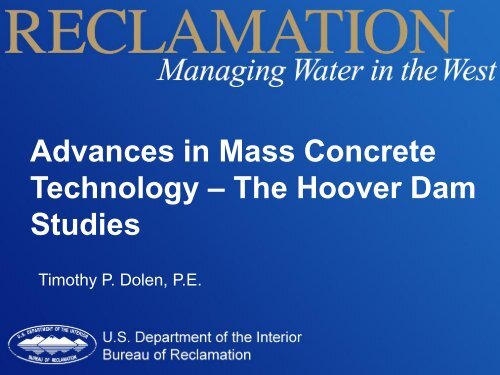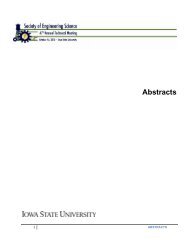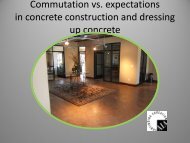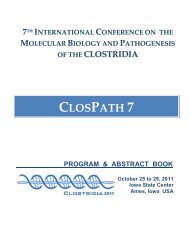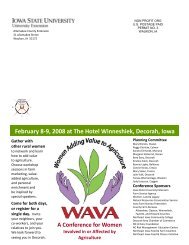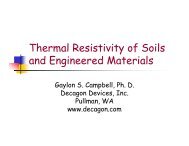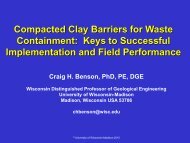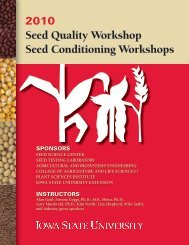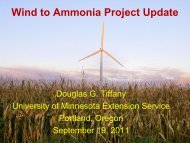Advances in Mass Concrete Technology â The Hoover Dam Studies
Advances in Mass Concrete Technology â The Hoover Dam Studies
Advances in Mass Concrete Technology â The Hoover Dam Studies
You also want an ePaper? Increase the reach of your titles
YUMPU automatically turns print PDFs into web optimized ePapers that Google loves.
<strong>Advances</strong> <strong>in</strong> <strong>Mass</strong> <strong>Concrete</strong><br />
<strong>Technology</strong> – <strong>The</strong> <strong>Hoover</strong> <strong>Dam</strong><br />
<strong>Studies</strong><br />
Timothy P. Dolen, P.E.
Evolution of <strong>Mass</strong><br />
<strong>Concrete</strong> <strong>Dam</strong><br />
Construction
Introduction<br />
• <strong>The</strong> Problem – Strength vs. Heat<br />
• Investigations of Portland Cements<br />
– Chemical Composition of Portland Cements<br />
– Strength Development<br />
– Heat of Hydration / Temperature Rise<br />
• <strong>The</strong> <strong>Mass</strong> <strong>Concrete</strong> “Recipe for Success”<br />
– Mixture Proportion<strong>in</strong>g and Properties of Fresh <strong>Concrete</strong><br />
– Compressive Strength and Elastic Properties<br />
– Size Effects<br />
– Permeability<br />
• <strong>The</strong>rmal Properties of <strong>Mass</strong> <strong>Concrete</strong><br />
• Bond Strength of Lift L<strong>in</strong>es<br />
• Construction Firsts<br />
• Conclusions
<strong>The</strong> giant leap forward!<br />
Buffalo Bill<br />
1905-1910<br />
350 ft<br />
87,515 yd 3<br />
Owyhee<br />
1928-1932<br />
417 ft<br />
537,500 yd 3<br />
<strong>Hoover</strong><br />
1931-1936<br />
726 ft<br />
4,400,000 yd 3
<strong>The</strong> Problem - Strength vs. Heat<br />
Portland cement ga<strong>in</strong>s strength through<br />
the chemical process of “hydration.”<br />
But, hydration of cement is an exothermic<br />
reaction that generates heat.<br />
<strong>The</strong> <strong>in</strong>ability of such a massive structure<br />
to dissipate heat leads to the potential for<br />
thermal crack<strong>in</strong>g.
Cement Investigations<br />
Great collaboration between government,<br />
academia, manufacturers and trade<br />
associations.<br />
• Chemical composition of cement<br />
• Heat of hydration of cement<br />
• Physical properties and strength of mortar<br />
• Durability <strong>in</strong>vestigations<br />
• Manufactur<strong>in</strong>g processes<br />
Berkley cement <strong>in</strong>vestigations – 15,429 tests!
Composition of Portland Cement<br />
Component Elements (raw feed)<br />
Clay, limestone, iron + = “”cl<strong>in</strong>ker”<br />
“Cl<strong>in</strong>ker”<br />
Compound Oxides (CaO, SiO 2 , Al 2 O 3 , Fe 2 O 3 )<br />
Cement Compounds<br />
C 3 S C 2 S C 3 A C 4 AF<br />
b<strong>in</strong>der – “gel”<br />
(strength)<br />
Hydration Products<br />
Ca(OH) 2 – lime<br />
HEAT
Hydration of Portland Cement<br />
Cement Compounds<br />
C 3 S C 2 S C 3 A C 4 AF<br />
+ = +<br />
Cement “gel” + lime
Strength Development of Portland Cement<br />
C 3 A (
Heat of Hydration of Portland Cement<br />
C 3 A ( 7 days)<br />
C 4 AF
Chemical Composition of Cements<br />
C 3 S C 2 S C 3 A C 4 AF<br />
Low Heat 23 50 5 14<br />
Standard 50 25 10 8<br />
“Modified<br />
GCD”<br />
46 30 5 13
Physical Properties of Mortar<br />
Compressive<br />
Strength (psi)<br />
Heat of Hydration<br />
(cal/g)<br />
7 day 28 day 7 day 28 day<br />
Low Heat 1,770 3,760 55 64<br />
Standard 2,660 3,350 85 97<br />
“Modified<br />
GCD”<br />
2,720 5,030 75 82
<strong>Concrete</strong> Mixture Proportion<strong>in</strong>g<br />
Investigations<br />
0.5 Water : 1 Cement : 2.45 Sand : 7.05 Aggregate<br />
• Nom<strong>in</strong>al maximum size aggregate (NMSA)<br />
• Aggregate grad<strong>in</strong>g / sand – aggregate ratio<br />
• NMSA vs. paste volume<br />
• Properties of fresh concrete<br />
• Properties of hardened concrete
Nom<strong>in</strong>al Maximum Size Aggregate<br />
6 ft !<br />
Elephant Butte <strong>Dam</strong><br />
“plum stones” 1916
Arizona<br />
Gravel<br />
Deposit<br />
NMSA = 8-9 <strong>in</strong>
<strong>Mass</strong> <strong>Concrete</strong> Fresh Properties<br />
Slump – 3 <strong>in</strong>.
NMSA vs.<br />
Paste<br />
Content<br />
Paste<br />
(Cement + Water)<br />
F<strong>in</strong>e<br />
Aggregate<br />
Coarse<br />
Aggregate
Effect of NMSA on Paste Content<br />
100%<br />
90%<br />
80%<br />
70%<br />
60%<br />
50%<br />
40%<br />
30%<br />
20%<br />
10%<br />
0%<br />
0.53 0.49 0.47<br />
0.28<br />
0.27<br />
0.25<br />
0.19 0.24 0.28<br />
8 <strong>in</strong> NMSA<br />
380 lb / cy<br />
3 <strong>in</strong> NMSA<br />
460 lb/cy<br />
1-1/2 <strong>in</strong> NMSA<br />
560 lb/cy<br />
Coarse Aggregate Volume<br />
Sand Volume<br />
Paste Volume<br />
3 <strong>in</strong>ch slump<br />
Cement content<br />
lb per cubic yard
Compressive Strength and Elastic<br />
Properties of <strong>Mass</strong> <strong>Concrete</strong><br />
• Effect of cement type<br />
• Effect of NMSA<br />
• Test age<br />
• Water / cement (W/C) ratio<br />
• Cur<strong>in</strong>g condition<br />
• Plac<strong>in</strong>g temperature<br />
• Cyl<strong>in</strong>der size (effect of wet screen<strong>in</strong>g)
Compressive Strength - psi<br />
Compressive Strength vs. W/C ratio<br />
5000<br />
Compressive Strength of <strong>Mass</strong> <strong>Concrete</strong><br />
<strong>Hoover</strong> <strong>Dam</strong> Laboratory Test Program<br />
4000<br />
3000<br />
2000<br />
1000<br />
0<br />
Note - average core compressive<br />
strength at 60 years age - 7,410 psi<br />
0 100 200 300 400<br />
Test Age - days<br />
W/C - 0.66<br />
W/C - 0.54<br />
W/C - 0.47<br />
Power (W/C - 0.66)<br />
Power (W/C - 0.54)<br />
Power (W/C - 0.47)
NMSA vs. Test Specimen Size
Test Specimen Size
Compressive Strength of <strong>Mass</strong> <strong>Concrete</strong><br />
Size Effects
NMSA vs. Test Specimen Size<br />
NMSA<br />
(<strong>in</strong>)<br />
Test Cyl<strong>in</strong>der<br />
Size (<strong>in</strong>)<br />
Volume<br />
(ft 3 )<br />
<strong>Mass</strong><br />
(lb)<br />
“9” 36 x 72 42.4 6,530 *<br />
6 24 x 48 12.6 1,935<br />
3 12 x 24 1.6 240<br />
1-1/2 6 x 12 0.2 30<br />
3/4 3 x 6 0.03 4<br />
* Approximately 250 shovels full of aggregate
Batch<strong>in</strong>g <strong>Mass</strong> <strong>Concrete</strong> <strong>in</strong> the<br />
Laboratory
6,530 lbs. - approximately 250 shovels<br />
full of aggregate per test specimen!<br />
Grant Wood - 1930
Elastic Properties of <strong>Concrete</strong>
Modulus of Elasticity - 10 6 psi<br />
Modulus of Elasticity of <strong>Mass</strong> <strong>Concrete</strong><br />
7<br />
6<br />
5<br />
4<br />
3<br />
2<br />
1<br />
0<br />
Modulus of Elasticity of <strong>Mass</strong> <strong>Concrete</strong><br />
<strong>Hoover</strong> <strong>Dam</strong> Laboratory Test Program<br />
Note - average coremodulus of elasticity<br />
at 60 years age - 6.65 X 10 6 psi<br />
0 100 200 300 400<br />
Test Age - days<br />
W/C - 0.66<br />
W/C - 0.54<br />
W/C - 0.47<br />
Power (W/C - 0.66)<br />
Power (W/C - 0.54)<br />
Power (W/C - 0.47)
<strong>The</strong>rmal Properties<br />
• Conductivity<br />
• Specific heat<br />
• Diffusivity<br />
• <strong>The</strong>rmal Expansion<br />
• Adiabatic Temperature Rise
Test Conditions<br />
Conductivity<br />
(Btu/(ft-hr- o F)<br />
<strong>The</strong>rmal Properties<br />
Specific Heat<br />
(Btu/(lb- o F)<br />
Diffusivity<br />
(ft 2 /hr)<br />
Type of coarse<br />
aggregate varied<br />
through range of tests.<br />
1.2 to 2.0<br />
Varied as much<br />
as 42 percent<br />
0.23 to 0.245<br />
Varied as much<br />
as 8 percent<br />
0.032 to 0.058<br />
Varied as much<br />
as 47 per cent<br />
Water content<br />
<strong>in</strong>creased from 4 to 8<br />
per cent of the<br />
concrete by weight.<br />
(1.7 to 1.55)<br />
Decreased as<br />
much as 10<br />
percent<br />
(0.22 to 0.24)<br />
Increased as<br />
much as 12<br />
percent<br />
(0.049 to 0.042)<br />
Decreased as<br />
much as 16<br />
per cent<br />
Mean temperature of<br />
concrete <strong>in</strong>creased<br />
from 50 to 150 o F.<br />
Increased as<br />
much as 12 per<br />
cent and<br />
decreased as<br />
much as 6<br />
percent<br />
Increased as<br />
much as 24<br />
percent<br />
Decreased as<br />
much as 21<br />
per cent
<strong>The</strong>rmal Conductivity Test<strong>in</strong>g Equipment
<strong>The</strong>rmal Expansion 10 -6 <strong>in</strong>/<strong>in</strong> per o F<br />
<strong>The</strong>rmal Expansion of <strong>Mass</strong> <strong>Concrete</strong><br />
5.5<br />
5<br />
4.92<br />
Quartzose<br />
Sandstone<br />
4.8<br />
5.18<br />
5.01<br />
5.2 5.27<br />
4.5<br />
4<br />
3.9<br />
Granite<br />
3.98 4<br />
4.3<br />
4.4<br />
3.97<br />
3.5<br />
3<br />
Vesicular<br />
Basalt<br />
3.01<br />
3.33<br />
2.5<br />
2<br />
2.1<br />
1.5<br />
1<br />
<strong>The</strong>rmal Expansion <strong>Mass</strong><br />
<strong>The</strong>rmal Expansion RCC
Adiabatic *<br />
Temperature<br />
Rise of <strong>Mass</strong><br />
<strong>Concrete</strong><br />
* No heat loss or ga<strong>in</strong>
Temperature Rise - o F<br />
Temperature Rise of <strong>Mass</strong> <strong>Concrete</strong><br />
70<br />
60<br />
50<br />
40<br />
30<br />
20<br />
10<br />
0<br />
Adiabatic Temperature Rise<br />
<strong>Hoover</strong> <strong>Dam</strong> <strong>Mass</strong> <strong>Concrete</strong><br />
0 5 10 15 20 25 30<br />
Test Age - days<br />
Low Heat Cement<br />
Standard Cement<br />
Modified Cement
Permeability of <strong>Mass</strong> <strong>Concrete</strong>
Bond Strength of <strong>Mass</strong> <strong>Concrete</strong> Lift<br />
L<strong>in</strong>es<br />
• Effect of concrete<br />
strength<br />
• Time between plac<strong>in</strong>g<br />
lifts<br />
• Cur<strong>in</strong>g of lift l<strong>in</strong>es<br />
• Temperature dur<strong>in</strong>g lift<br />
exposure<br />
• Method of lift l<strong>in</strong>e<br />
clean<strong>in</strong>g<br />
• Bond<strong>in</strong>g mortar
Recipe for Success - <strong>The</strong> solution – Low<br />
heat cement for <strong>Hoover</strong> <strong>Dam</strong> mass<br />
concrete – 8 <strong>in</strong> NMSA – Post cool<strong>in</strong>g<br />
Strength (psi) to Heat (cal/g) ratio<br />
3 days 7 days 28 days<br />
Low Heat 32 46 65<br />
Standard 41 46 50<br />
“Modified<br />
GCD”<br />
42 53 60
<strong>Hoover</strong> <strong>Dam</strong> Historic Firsts
<strong>Concrete</strong> batch<strong>in</strong>g and plac<strong>in</strong>g
Over 100 years to cool down!
“Chut<strong>in</strong>g” concrete <strong>in</strong>to place - ~1908 – 1928)<br />
(the flatter the slope – the more water added)
Highl<strong>in</strong>e – bucket plac<strong>in</strong>g
Block plac<strong>in</strong>g and post cool<strong>in</strong>g
Post cool<strong>in</strong>g and grout<strong>in</strong>g<br />
Closure<br />
Slot
Black Canyon <strong>Dam</strong> - 1924<br />
Bleed<strong>in</strong>g<br />
Segregation
Lower slump mass concrete
Unsung hero – the <strong>in</strong>ternal vibrator<br />
6 <strong>in</strong> > 2-3 <strong>in</strong> slump<br />
10 – 20 % less water<br />
25 – 50 lb less cement<br />
10 – 15 °F less heat
Conclusions – <strong>Mass</strong> <strong>Concrete</strong><br />
• Unprecedented <strong>in</strong> scope<br />
Investigations<br />
• Unprecedented <strong>in</strong> complexity<br />
• Unprecedented <strong>in</strong> difficulty<br />
• Verification followed each stage of laboratory test<strong>in</strong>g<br />
and large scale mass concrete construction<br />
• <strong>The</strong> systematic methodology of mixture<br />
proportion<strong>in</strong>g <strong>in</strong>vestigation still followed today<br />
• Database of materials thermal properties still used<br />
today<br />
• Construction <strong>in</strong>novations still followed today
Special thanks to all of the eng<strong>in</strong>eers and laboratory<br />
technicians for their achievements, especially anyone<br />
who has ever had to manipulate a 12 <strong>in</strong>ch diameter<br />
(or larger) test specimen!
Thank you<br />
for your<br />
attention


